Mulch effectively maintains soil structure and protects plants from drought, rain, and snow. Biodegradable mulches also provide nutrients so flowers and veggies can grow large and healthy, but is fall the correct time to apply mulch? Should you add more mulch to your yard in the fall? Discover when it’s best to add more mulch, plus all the important things to know first, such as what mulch is anyway and what type is best. We’ll finish up with a rundown on the reasons why mulch is so important in the fall.
Should You Add More Mulch in the Fall?
Yes, you should add more mulch to the yard in the fall. Falltime mulch provides lots of benefits, which we’ll go into later. When fall arrives, it seems like the garden is fading away for winter, but gardening is a 12-month-old hobby. Your plants need help over the winter, and fall is the ideal time to set up.
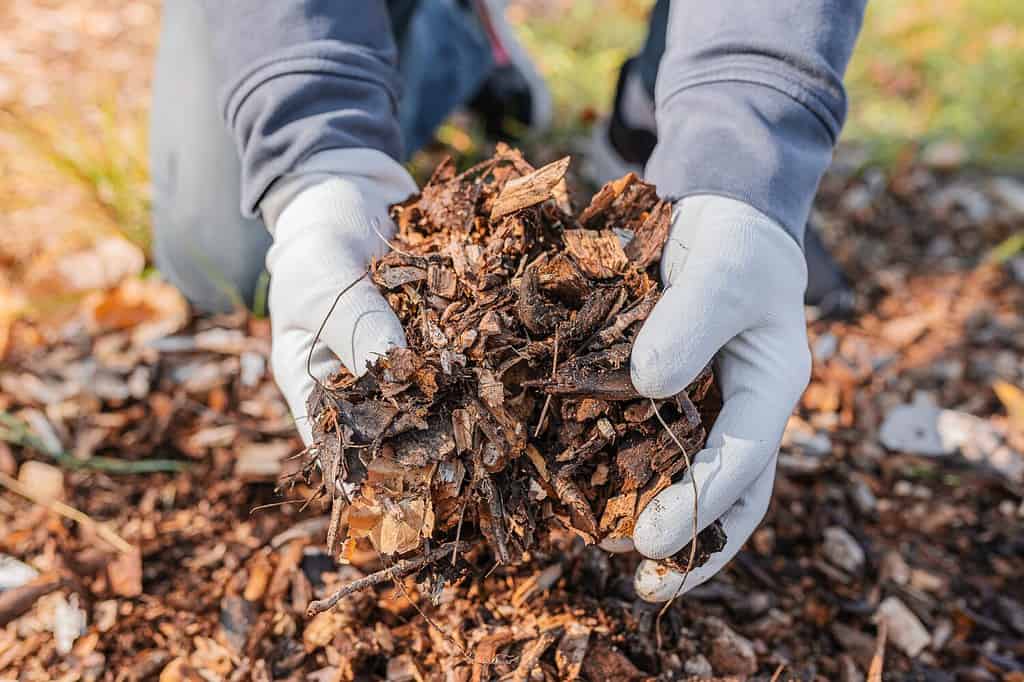
In the fall, you should add more mulch to the yard to protect soil and plants from winter elements.
©larisa Stefanjuk/Shutterstock.com
What Is Mulch Anyway?
Mulch is a protective layer of organic or hard material that guards plants and soil against the elements and pests. Biodegradable mulch also provides plants with a trickle of consistent nutrients at a nice slow rate so their roots can easily absorb it when required.
Good mulching materials include the following:
Biodegradable
- Untreated grass clippings
- Pine needles
- Wood chips and bark
- Shredded leaves
- Compost
- Straw
- Coir
Non-biodegradable
- Rubber chippings
- Stone
- Slate
- Shingle
- Gravel
- Tumbled seashells
When Is the Best Time to Add Mulch?
Most gardeners agree that the best time to add mulch is early spring because it traps moisture from winter’s rainfall and prevents weeds from springing up. Biodegradable mulch also feeds plants over the coming summer. The second best time to apply mulch is fall. However, for the best blooming plants, savvy gardeners apply biodegradable mulch in spring and then more mulch in fall.
Important Things to Know First
There’s work to do before adding fall-time mulches!
1. Clean up First
Spend time clearing detritus away from the flower beds or veggie patch first. Pick up old stems and leaves, any stones, and pull weeds. Use this time to thoroughly check perennials and evergreens over. Cut away dead or damaged branches and remove any diseased plants so they can’t spread infection.
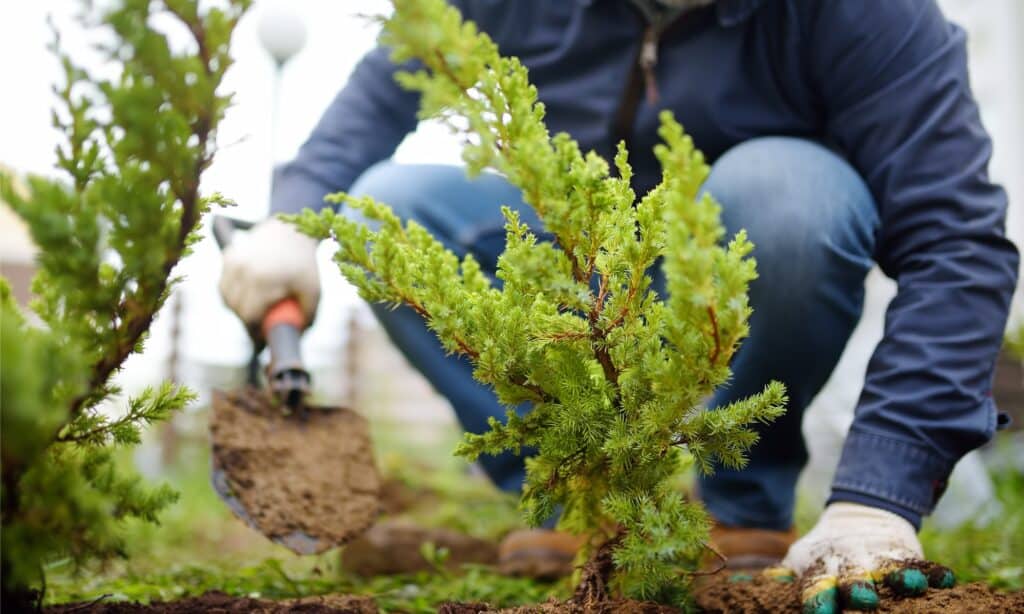
Before adding more mulch in fall, clear away weeds, stones, and diseased plants.
©iStock.com/SbytovaMN
2. When to Mulch in the Fall
It’s tempting to throw down more mulch when the weather is warm, and plants look happy, but the best time to mulch in fall is after the first deep frost.
Laying mulch after the first frost is best because frost sends signals to plants. It tells them it’s time to go dormant. If their roots stay toasty warm, then plants continue to grow. Unfortunately, new foliage is destroyed by future frosts, potentially harming the whole plant.
But if you leave it longer than the first frost, plants may succumb to the elements.
Mulching after the first frost means keeping an eye on the weather forecast. Frost occurs at different times depending on where you live. It’s a good idea to gather a big pile of mulch at summer’s end so you’re ready to apply when the time is right.

Mulch after the first fall frost so plants know it’s time to go dormant for winter.
©Anne Richard/Shutterstock.com
3. How Much Mulch Is Best?
To be effective, at least two inches of biodegradable mulch around roots are required. More than two inches is preferable, but commercially purchased mulch is expensive, and it’s hard work spreading it out.
Use a shovel to move mulch to the flower beds, and evenly spread it out with a fork or your hands. Avoid getting any mulch on stems, trunks, and old wood because it can cause rot.

Add at least two inches of biodegradable mulch to the soil in the fall.
©OzCameraman/Shutterstock.com
4. Why Is Mulch in Fall Effective?
Mulching is one of the best ways to support your yard. Here are seven reasons you should add more mulch to the yard in fall.
Root Protection
In the fall, a layer of biodegradable or non-biodegradable mulch protects plant roots from frost, snow, and excess rain. The extra depth can also help protect roots from hungry pests such as rabbits.

Adding mulch in the fall protects plant roots from extreme winter weather.
©4028mdk09 / CC BY-SA – License
Heat Protection and Food in Early Spring
Early spring sometimes arrives with a bang before gardeners are ready to don their non-slip waterproof shoes. The elements won’t wait for you! If temperatures rise and the sun shines strongly, it can damage plants without mulch to protect them against sudden temperature changes and dry conditions. A thick layer of mulch applied in the previous fall buys time.
In the same vein, early spring gives perennials and biennials a boost, and they’ll start growing with or without spring mulch. Fall-time mulch means your plants have some nutrients ready to go until you apply their new nutrient-rich springtime mulch.

If spring arrives early, fall-time mulch gives plants a headstart.
©Jackie Tweddle/Shutterstock.com
Weed Suppression
Applying more mulch in the fall suppresses weed growth. Weeds are tough plants, capable of continuing the life cycle when temperatures drop. A thick layer of mulch after the first frost blocks out light and water so weed seeds can’t germinate. It also prevents fresh seeds from getting hold, and this means less tedious weeding the following spring.
Feed Winter Growing Plants
Some plants grow in the winter! Take winter-blooming clematis for example. This plant needs fall-time mulch to flower well for Christmas. The same goes for mahonia, winter flowering jasmine, witch hazel, and hellebores. A full-time application of nutrient-rich organic mulch boosts winter-time flowerers.
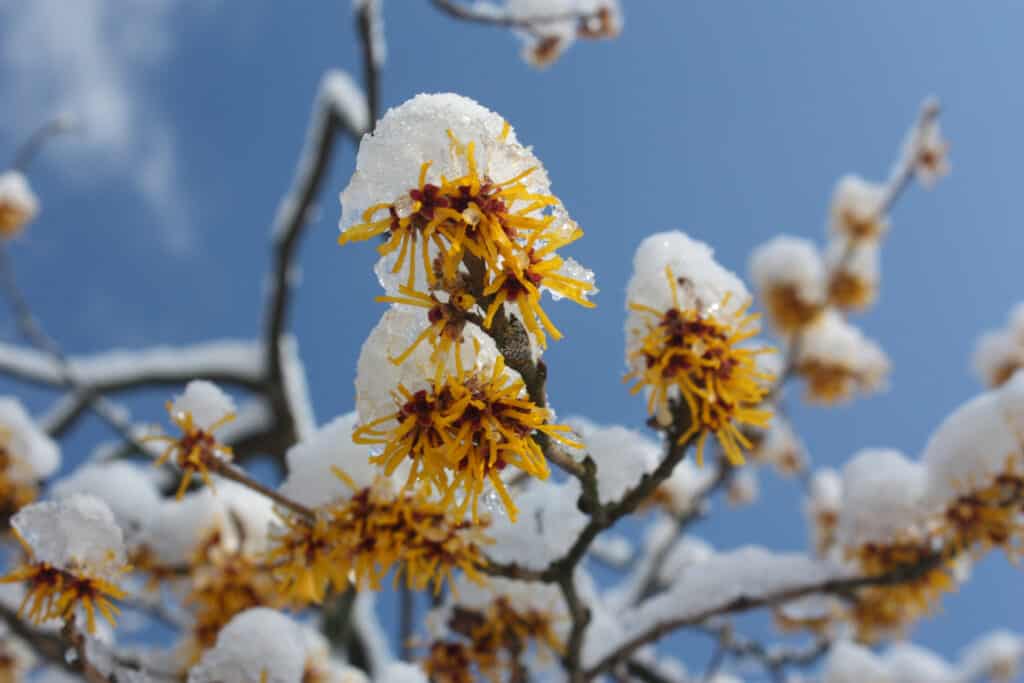
Witch hazels flower in winter, so in the fall, mulch provides them with nutrients.
©iStock.com/odluap
Traps Moisture
Many garden plants don’t need much water over winter, but they need some. Fall-time mulch keeps out excessive rainfall, but it traps moisture beneath. Moreover, fall mulches last well into the following season, keeping plants moist into spring and early summer.
Improves Soil
Biodegradable mulches like wood chips improve the soil’s condition over winter, breaking down to slowly release its nutrients.
Warm, moisture-trapping mulch also attracts earthworms that pull down organic matter to eat and, in doing so leave small tunnels that create air circulation. This improves soil structure.
Fall mulches also protect soil against heavy rainfall that washes away topsoil and nutrients.
Fall Time Mulch Looks Good
All gardeners like to step back and admire their hard work. Mulch is one of those aspects that makes a massive impact on the yard’s presentation. It covers stony, weedy soil with a layer of handsome color. Mulch looks great in place and throughout winter because it prevents soil from splashing up, ugly exposed roots, and brown water running into other areas of the garden.
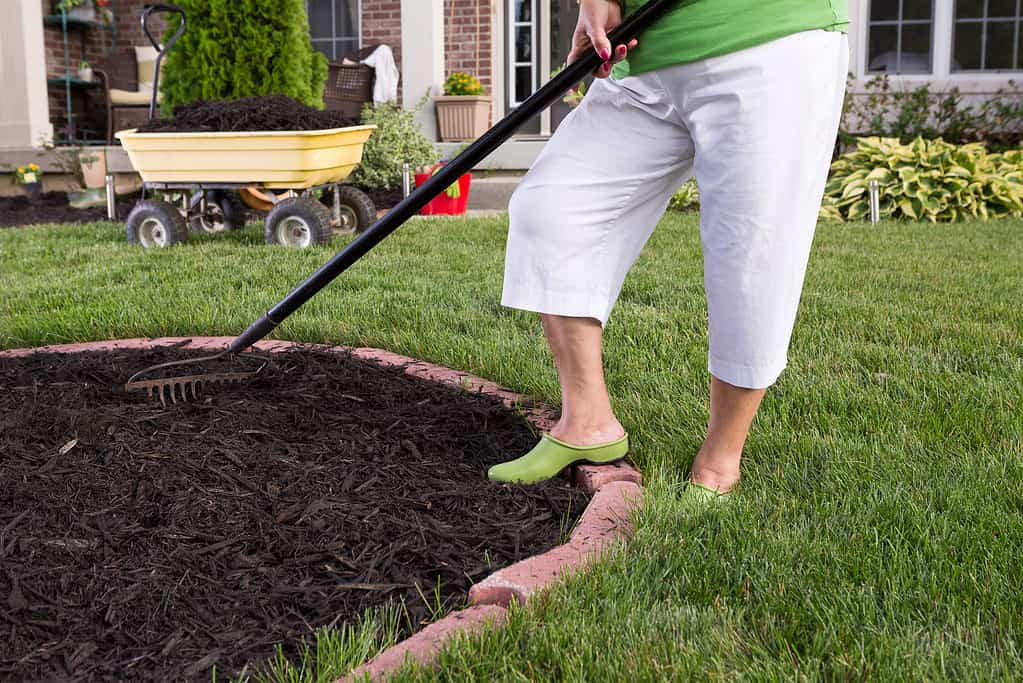
Spreading more mulch in the fall keeps the yard looking good all year round.
©iStock.com/ozgurcoskun
What Type of Mulch Should I Use in the Fall?
The biodegradable mulches listed above look good and provide nutrients. In general, biodegradable mulch is preferable. Just be sure to pick the most suitable; for example, acidic-loving plants like azaleas and rhododendrons prefer an acidic mulch like pine or bracken mulch.
However, non-biodegradable mulch has its place, and its decorative nature is unsurpassed. You’ll generally only apply this once, and fall is a good time, so winter climates don’t take their toll on your plants. Non-bio mulches prevent weeds from growing or establishing in the soil, and they trap moisture, too.
Before applying non-biodegradable mulch, lay a permeable weed membrane. This stops your expensive hard landscaping from disappearing into the soil over time. Permeable membranes ensure plants can still access rainfall and stop runoff.
Cut holes in the membrane to fit existing plants, but before you finally lay the membrane, top plants up with a thick layer of organic matter.
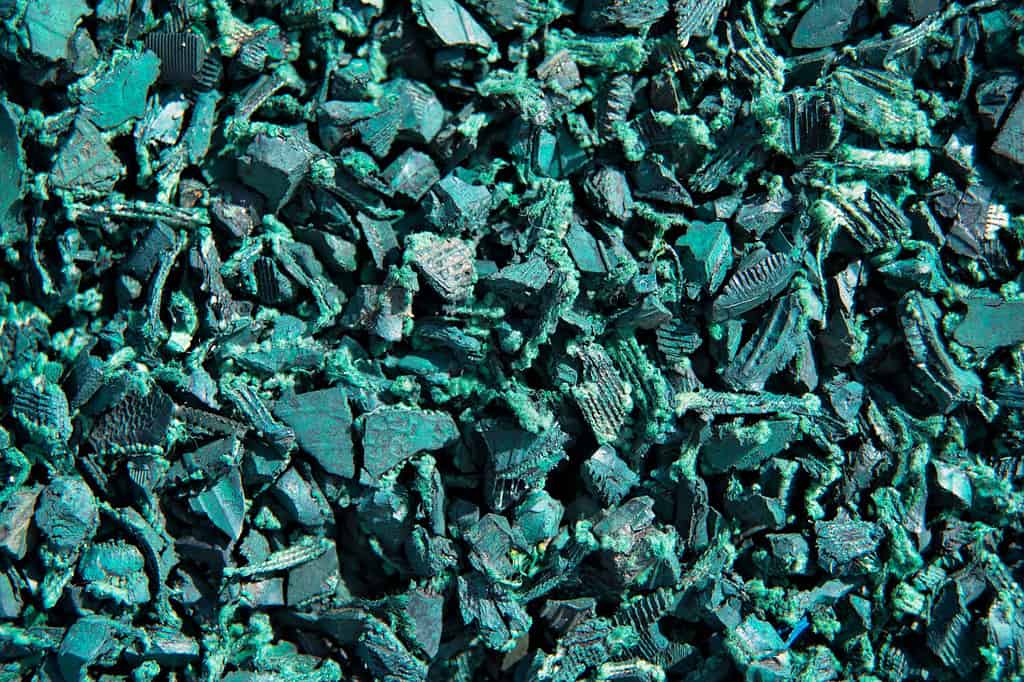
Recycled rubber mulch is an effective, non-biodegradable mulch that traps moisture and suppresses weeds.
©Kayla Blundell/Shutterstock.com
Mulch in Fall: Why It’s Important
Mulch is a plant’s guardian angel. It protects and nurtures plants in ways that liquid feeds and hose pipe watering can’t replicate.
If you’re wondering if you should bother adding more mulch to the yard in the fall, you definitely should. Here’s a reminder of why:
- Root protection
- Soil protection
- Weed suppression
- Traps moisture
- Preserves and enhances soil structure
- It looks great
In addition, biodegradable mulch adds nutrients that keep evergreens and winter-blooming plants happy and gives perennials and biennials a headstart as soon as spring arrives.

A layer of mulch protects and nurtures yard plants. It’s an essential part of a healthy ecosystem.
©iStock.com/beekeepx
The photo featured at the top of this post is © Ozgur Coskun/Shutterstock.com
Thank you for reading! Have some feedback for us? Contact the AZ Animals editorial team.






